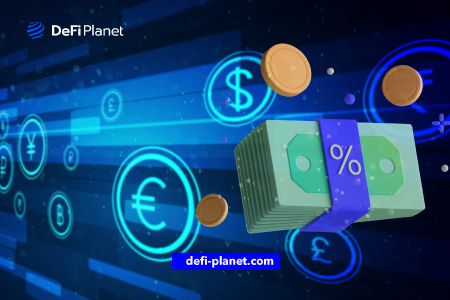Last updated on November 17th, 2022 at 12:25 pm
Digital currency adoption is reshaping the global financial, monetary, and regulatory landscapes. Private digital currencies have the potential to disrupt the market by lowering the cost of payments and making the financial system more user-friendly. They also expedite settlement transactions and make sure that they are error-free.
However, new technology introduces new challenges. Market forces can cause price volatility, and new technologies can pose operational challenges.
Digital currencies must be resistant to threats such as cyber-attacks, and they must be backed by laws and regulations that effectively address issues such as loss, counterfeiting, privacy, money laundering, and consumer protection.
Understanding how digital currencies operate and the effects they may have can assist us in preparing for these changes to the global financial system.
What are Stablecoins?
Stablecoins were created to address the issue of volatility. Their goal is to emulate traditional currencies while also using blockchain technology.
Blockchain is a digital transaction record with features such as transparency, security, immutability, digital wallets, fast transactions, low costs, programmability, and privacy without sacrificing the trust and stability associated with traditional currencies.
Digital money has been in the financial system for decades in the form of reserves. Stablecoins are unique in that they can be held by individuals rather than banks. It is a digital pocket change stored in your digital wallet instead of a bank account.
While many people regard bitcoin as digital gold, stablecoins and digital currencies are not the same. Bitcoin’s value is determined partly by the cost of manufacturing, or “mining,” new coins but also by market demand. This is similar to gold, where the value extends beyond the costs of mining, recycling, and storage. The value of a stablecoin is determined by its peg to a currency such as the US dollar.
Monetary Impacts
Multi-currency stablecoins can influence monetary policy transmission by boosting currency substitution and changing business cycle synchronization patterns. Currency substitution diminishes the control of monetary authorities over domestic liquidity due to the restriction of the capacity in which the authorities have direct influence and decreasing money demand stability. Substitution into multi-currency stablecoins is the same as substitution into traditional fiat currencies.
However, because of increased accessibility, stablecoins may increase currency substitution. Furthermore, it could encourage economic activity and trade links formed around big techs and help modify business cycle synchronization patterns, which could decrease monetary policy’s ability to respond to shocks.
The global adoption of a multi-currency stablecoin with an independent unit of account may subject countries to a private firm’s monetary view. Although privately printed money has circulated in various forms in the past, a universally adopted multi-currency stablecoin would be unparalleled in its scope. So, the effects of any possible use of the payment system and monetary position for private objectives could be more significant than the effects of any private money in the past.
Instead of striving for price and output stabilization in nations that utilize the multi-currency stablecoin, the issuer could modify the amount of issuance, the level of interest rates, or fees to maximize its profit. The potential for conflicts of interest is especially high if that corporation is also a major provider of credit, the demand for which may become dependent on its monetary posture.
If the multi-currency stablecoin implemented a price stabilization criterion relative to a basket of products supplied on the big tech platform, it could question the conceptions of ideal currency zones based on national business cycle synchronization.
Platform-based economic activity and other sectors of the economy may exhibit varying patterns. The industries closely linked to the platforms may become a source of shocks to other segments of the economy.
Also, if the stablecoins have a rate of return that can change, the changes to that rate of return may be different from what is needed to keep other parts of the economy stable.
The monetary policy consequences of multipolarity differ depending on whether the multipolarity is defined by countries’ currency blocs or by intra-country currency rivalry. If multipolarity is defined by country blocs, with each country adopting one CBDC or multi-currency stablecoin, then the monetary policy consequences for countries that use it would be the same as for countries that use a single currency. Each stablecoin bloc would resemble a currency union rather than a “dollarized” economy.
However, monetary policy can only be tailored to the bloc as a whole; countries with business cycles that differ from the average bloc member may be excluded.
Nonetheless, if the home currency is still in use, several currencies may complicate exchange rate anchoring. Many nations that have suffered currency substitution into a single foreign currency have shifted their monetary policies to minimize the movement of bilateral exchange rates so that domestic balance sheets (exposed to the foreign currency) can be stabilized. However, with many currencies, exchange rate variations between them would hamper such stabilizing efforts.
Multi-currency stablecoins can limit central banks’ ability to oversee domestic financial conditions and provide emergency liquidity support during times of stress. Financial circumstances reflect the underlying price of risk in the economy and measure the cost of finance. Changes in the economy can make people less likely to take risks and make the financial system more vulnerable, which affects both business activity and the stability of the economy over time
As the global financial system becomes more connected, so-called global financial cycles have become increasingly influential in individual countries’ domestic financial conditions. The widespread use of multi-currency stablecoins could amplify this trend.
Global financial cycles may be linked to perceived changes in the safety of the arrangement of the multi-currency stablecoin’s ecosystem. They could also be influenced by changes in interest rates initiated by the stablecoin issuer. As a result, it may be more difficult for local central banks to limit boom-and-bust patterns.
The multi-currency stablecoin may exacerbate risks caused by currency imbalances among banks and consumer borrowers because of its increased accessibility. The stablecoins, if not adequately safeguarded, may promote illicit transfers and make it more difficult for regulatory agencies to implement exchange limitations and capital flow management regulations. The integrity of multi-currency stablecoins may impact financial stability if the integrity of their peg to fiat currency is questioned.
Greater currency substitution caused by multi-currency stablecoins’ acceptance may also make it more difficult for central banks to control “run risks” in difficult times. A run on the banking system is frequently coupled with a run on the currency or the country in many emerging markets and developing countries. Depositors would be incentivized to relocate their wealth into foreign assets in such instances.
Global adoption of multi-currency stablecoins may pose systemic hazards due to their interdependence. Pressures on any component of the multi-currency stablecoin ecosystem could spread fast across borders. Failure of a service provider (such as wallet providers, resellers, managers, or custodians of reserve assets) in one country may cause users in another jurisdiction to doubt the stablecoin’s safety and reliability.
Finally, flaws in one jurisdiction may endanger the entire ecosystem. This could cause the global payment system to fail, making it hard for people to send and receive money around the world.
Currency rivalry within a jurisdiction may make local financial circumstances more volatile in a multipolar setting. Participation in a digital currency area or currency bloc may be unstable due to the low switching costs between CBDCs and multi-currency stablecoins.
Although competition may encourage risk management discipline to sustain the attractiveness of privately produced money, in the long run, currency competition may only provide stability under specific conditions.
The adoption of multi-currency stablecoins may aid in lowering transaction costs and frictions in international capital markets. Multi-currency stablecoins, when combined with big data obtained from e-commerce and social networking platforms, may enable superior cross-border credit analytics and help reduce information asymmetries from the standpoint of a lender or investor.
A decrease in search and transaction costs could make it easier for less developed countries or small businesses around the world to get money from global capital markets.
In Conclusion,
- Stablecoins have tremendously grown in value over the past year as digital assets have gained widespread popularity and the applications of programmable digital currencies have become clearer. People are worried that this fast rise will harm the operations of banks and the traditional financial system.
- As the pace of digitalization accelerates, the international financial landscape will most likely be upended. Payments and financial services will almost certainly become more integrated with the digital economy, which is organized through e-commerce and social networking platforms. The rise of multi-currency stablecoins may be reminiscent of a time when the private sector had a key role in monetary policy, with ‘Big Tech’ not only delivering goods and services but also payment tools with the potential to influence monetary policy in many nations.
- Government authorities will undoubtedly encounter significant challenges in balancing the benefits and risks associated with multi-currency stablecoins. Some governments may decide to impose an outright ban on the use of stablecoins. Even so, ensuring that limiting restrictions are effectively implemented may be difficult. This will be determined in part by the countries’ technological capabilities.
If you would like to read more articles like this, visit DeFi Planet and follow us on Twitter, LinkedIn, Facebook, and Instagram.
“Take control of your crypto portfolio with MARKETS PRO, DeFi Planet’s suite of analytics tools.”





















